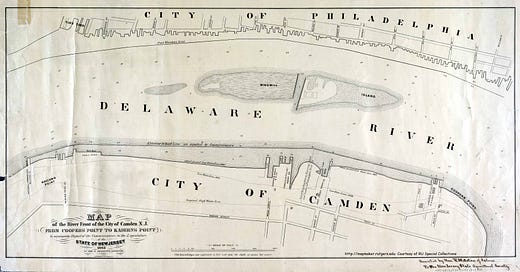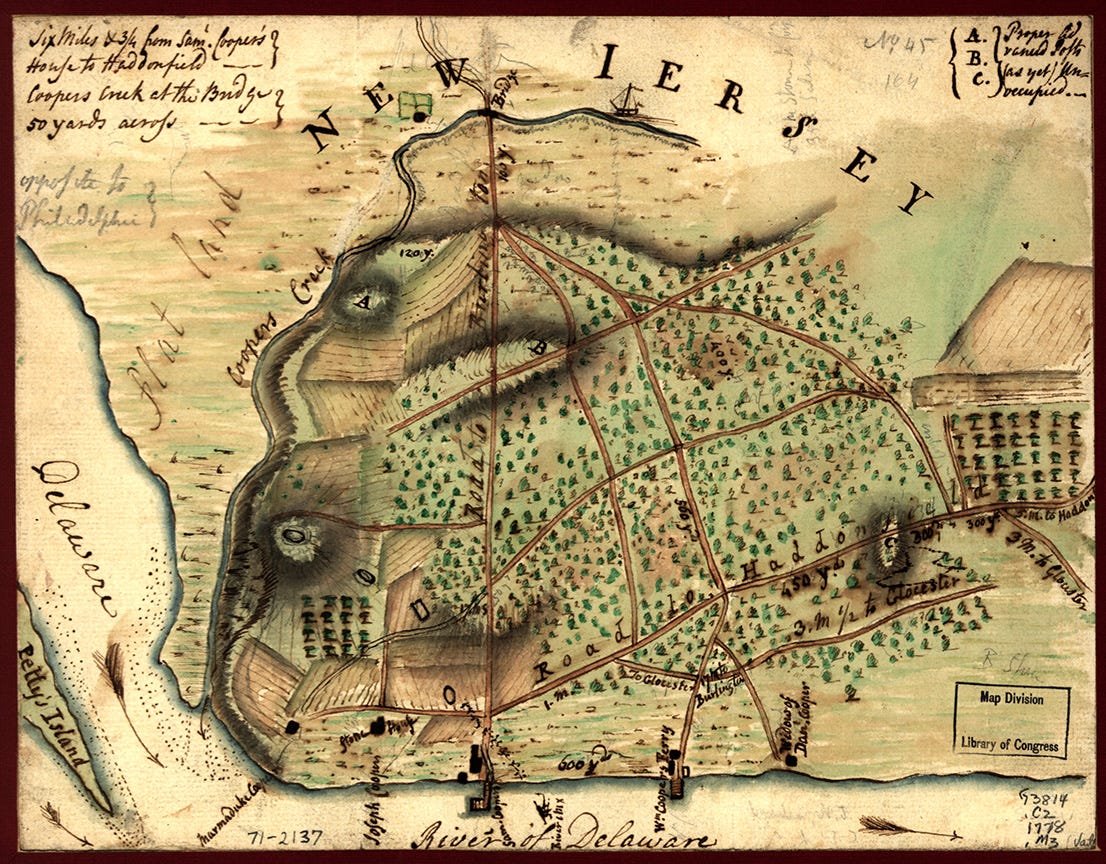Hometown History Homework #4: Cooper's Ferry (Camden, N.J.)
I have to apologize in advance. This is going to be another too brief recap of a place that has enough history to fill a whole season of Hometown History NJ. But we have to talk about the city of Camden, NJ.
How I got here:
Last weekend I happened to be driving through Camden County NJ (home of the toddler mecca “Diggerland USA”). The last time I had driven through this part of the state was almost ten years ago, when I made regular trips from Philadelphia, where I lived, to see my boyfriend, now husband, in Hoboken NJ. Back then I thought of Camden as just the city outside of Philly, a place where the roads could use some touching up. It was simply a pass-through point.
Now that I’ve been diving deep into the incredible historical legacy of New Jersey and its towns - big AND small - I thought it was time I give Camden the attention and respect it deserves.
The short version of the story:
The city of Camden is located in Camden County in South Jersey, or “West Jersey” as it was known back in the 17th and 18th centuries. Its strategic position along the east bank of the Delaware River made it an ideal spot for early European settlers, including Dutch, Swedish and English. When Quakers came and established a settlement in 1682 there were several hundred Lenni Lenape already living there. But these were Quakers, so their negotiations with native tribes proceeded quite peacefully.
The history of Camden is inextricably intertwined with a three hundred year old family by the name of Cooper. In 1679 William Cooper, an English Quaker, became one of the earliest Europeans to settle in what would become the city of Camden (a name chosen by William’s great grandson). William, his wife Margaret and their four children first settled in what was then Gloucester County (Camden County would not exist until 1844). A few years later he purchased 300 acres of land along one of the Delaware River’s main tributaries (soon to be named “Cooper’s Creek”). He built his estate there and named it “Pyne” (Pine) Point, also known as Coopers Point.
William, a blacksmith by trade, played a distinguished role in the early governance of West Jersey. He went on to become a member of the first colonial assembly and served as Justice of Gloucester County Courts.
In 1695 William’s son David Cooper established the earliest ferry service between Pyne Point and Philadelphia. This was a critical form of transportation for communication and commerce across the Delaware River. And later, it would be a strategic capture for British soldiers advancing from Philadelphia into West Jersey in 1778. According to the Camden County Historical Society:
On the evening of February 25, a second contingent [of British soldiers]…crossed from Philadelphia to Cooper’s Ferry. After establishing a strong guard at Cooper’s Ferry, the bulk of the 42nd and Queen’s Rangers headed to Haddonfield. A detachment of British soldiers under Colonel Markham also passed over the Delaware the next day and took post at Cooper’s ferry and foraged nearby.
Coopers Ferry was the nexus for transportation across the Delaware River throughout the 18th century. It was also the site of early slave auctions held in Camden. A newspaper advertisement in the 1727 American Weekly Mercury stated:
“To be sold by John Connor, a parcel of Negros Men, Boys and Girls at reasonable Rates, are to be seen at William Coopers on the Jersey and at Joseph Huggs at Gloucester.”
According to the City of Camden History website (which has an incredible interactive interface history lovers should check out) enslaved Africans were sold at three Camden ferry landings until 1761, when New Jersey imposed a stiff tariff on slaves as a means to end importation from Africa and the Caribbean. The last slave auctions were held in Camden in 1766.
Final thoughts:
I won’t try to convince anyone that the city of Camden is the next Jersey City, poised to become a bustling, revitalized New Jersey town for young people. It currently struggles with high crime rates and a sluggish business district, despite the valiant efforts of city officials to bring it back to it’s prominence (albeit, centuries ago) as the most important city in South Jersey.
But the story of Copper’s Ferry, it’s usefulness as a thoroughfare between Pennsylvania and New Jersey, it’s strategic and economic advantages, reminds me that these “pass through” points are important too. New Jersey as a state is sometimes written off as an “in between” space, some place you drive through on your way from Philadelphia to New York City. But there is richness and history there if you stop and investigate it. And I for one will never again underestimate the importance of a place like Camden and it’s history.
Links:
https://history.ci.camden.nj.us/
https://www.hmdb.org/m.asp?m=88384
https://amrevmuseumsnj.com/





